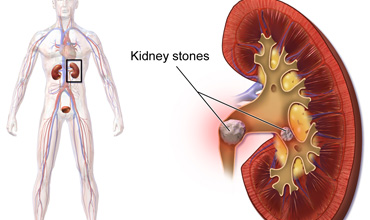Drinking Water Composition and Incidence of Urinary Calculus

Abstract:
This is the review of the article
“Drinking water composition and Incidence of Urinars calculus.’ It is study for
pathophysiology of urinary calculus due to electrolytes in water and whether
these electrolytes contribute to water quality besides hardness causing the
calculus formation.
References:
1.
Alapont Perez FM,
Galvez Calderon J, Varea Herrero J, Colome Borros G, Olaso Oltra A, Sanchez
Bisono JR. [Epidemiology of urinary lithiasis]. Actas Urol Esp. 2001;25:341-9.
Spanish.
2.
Barker DJ, Donnan
SP. Regional variations in the incidence of upper urinary tract stones in
England and Wales. Br Med J. 1978;1:67-70.
3. Basiri
A, Shakhssalim N, Khoshdel AR, Naghavi M. Regional and seasonal variation in
the incidence of urolithiasis in Iran: a place for obsession in case finding
and statistical approach. Urol Res. 2009.
4.
Bellizzi V, De
Nicola L, Minutolo R, et al. Effects of water hardness on urinary risk factors
for kidney stones in patients with idiopathic nephrolithiasis. Nephron. 1999;81
Suppl 1:66-70.
5.
Caudarella R,
Rizzoli E, Buffa A, Bottura A, Stefoni S. Comparative study of the influence of
3 types of mineral water in patients with idiopathic calcium lithiasis. J Urol.
1998;159:658-63.
6.
Churchill D, Bryant
D, Fodor G, Gault MH. Drinking water hardness and urolithiasis. Ann Intern Med.
1978;88:513-4.
7. Coen
G, Sardella D, Barbera G, et al. Urinary composition and lithogenic risk in
normal subjects following oligomineral versus bicarbonate-alkaline high calcium
mineral water intake. Urol Int. 2001;67:49-53.
8. Desmars
JF, Tawashi R. Dissolution and growth of calcium oxalate monohydrate. I. Effect
of magnesium and pH. Biochim Biophys Acta. 1973;313:256-67.
9.
Ettinger B, Pak CY,
Citron JT, Thomas C, Adams-Huet B, Vangessel A. Potassium-magnesium citrate is
an effective prophylaxis against recurrent calcium oxalate nephrolithiasis. J
Urol. 1997;158:2069-73.
10. Gershoff SN, Prien EL. Effect of daily MgO and vitamin B6
administration to patients with recurring calcium oxalate kidney stones. Am J
Clin Nutr. 1967;20:393-9.
11. Johansson G, Backman U, Danielson BG, Fellstrom B,
Ljunghall S, Wikstrom B. Biochemical and clinical effects of the prophylactic
treatment of renal calcium stones with magnesium hydroxide. J Urol.
1980;124:770-4.
12. Khan SR, Shevock PN, Hackett RL. Magnesium oxide administration
and prevention of calcium oxalate nephrolithiasis. J Urol. 1993;149:412-6.
13. Kohri K, Garside J, Blacklock NJ. The role of magnesium
in calcium oxalate urolithiasis. Br J Urol. 1988;61:107-15.
14. Kohri K, Kodama M, Ishikawa Y, et al. Magnesium-to-
calcium ratio in tap water, and its relationship to geological features and the
incidence of calcium-containing urinary stones. J Urol. 1989;142:1272-5.
15. Kohri
K, Ishikawa Y, Iguchi M, Kurita T, Okada Y, Yoshida O. Relationship between the
incidence infection stones and the magnesium-calcium ratio of tap water. Urol
Res. 1993;21:269-72.
16. Li MK, Blacklock NJ, Garside J. Effects of magnesium on
calcium oxalate crystallization. J Urol. 1985;133:123-5.
17. Meyer
JL, Smith LH. Growth of calcium oxalate crystals. II. Inhibition by natural
urinary crystal growth inhibitors. Invest Urol. 1975;13:36-9.
18. Ramello A, Vitale C, Marangella M. Epidemiology of
nephrolithiasis. J Nephrol. 2000;13 Suppl 3:S45-50.
19. Reungjui S, Prasongwatana V, Premgamone A, Tosukhowong P,
Jirakulsomchok S, Sriboonlue P. Magnesium status of patients with renal stones
and its effect on urinary citrate excretion. BJU Int. 2002;90:635-9.
20. Schwartz BF, Bruce J, Leslie S, Stoller ML. Rethinking
the role of urinary magnesium in calcium urolithiasis. J Endourol.
2001;15:233-5.
21. Sierakowski R, Finlayson B, Landes R. Stone incidence as
related to water hardness in different geographical regions of the United
States. Urol Res. 1979;7:157-60.
22. Shuster J, Finlayson B, Scheaffer R, Sierakowski R, Zoltek
J, Dzegede S. Water hardness and urinary stone disease. J Urol. 1982;128:422-5.
23. Singh PP, Kiran R. Are we overstressing water quality in urinary
stone disease? Int Urol Nephrol. 1993;25:29-36.
24. Sowers MR, Jannausch M, Wood C, Pope SK, Lachance LL,
Peterson B. Prevalence of renal stones in a population-based study with dietary
calcium, oxalate, and medication exposures. Am J Epidemiol. 1998;147:914-20.
25. Wickham JEA, Buck AC. Renal tract stone: metabolic basis
and clinical practice. Edinburgh: Churchill Livingstone; 1990.
26. Water
Quality Association [homepage on the internet]. Centralized “water softening” —
know the facts [cited 26 Jul, 2008]. Available from: http://www.wqa.org/sitelogic.cfm?ID=1052.
27. Zerwekh JE, Odvina CV, Wuermser LA, Pak CY. Reduction of
renal stone risk by potassium-magnesium citrate during 5 weeks of bed rest. J
Urol. 2007;177: 2179-84.

